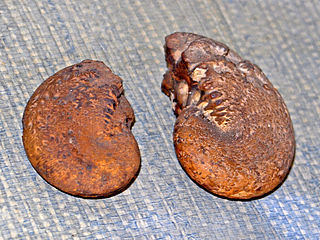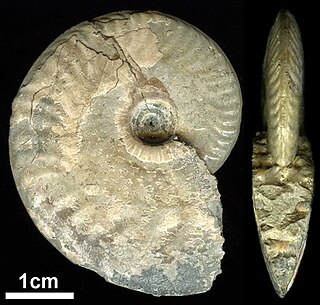Abbasites is an extinct genus of ammonites from the early Middle Jurassic epoch, included in the ammonitid family Erycitidae.

Parahoplitidae is an extinct family of Cretaceous ammonites with stoutly ribbed, compressed, generally involute shells lacking or with only minor tubercles included in the Deshayestoidea, a superfamily now separated from the Hoplitacaceae.
Cadomoceras is an extinct cephalopod genus from the order Ammonitida that lived during the Bajocian Stage of the Middle Jurassic, approximately 178 to 175 million years ago.
Praestrigites is a genus from the family Strigoceratidae which is included in the ammonitid superfamily Haploceratoidea.
Hebetoxyites is a genus of ammonoid cephalopod from the middle part of the Bajocian stage, middle Jurassic, included in the Strigoceratidae, Haploceratoidea. The shell is oxyconic, with a sharp rim but no keel, and involute, with the inner whorls hidden. The umbilicus is very small. Sides have a spiral ridge but are not striate.
The Strigoceratidae is a family in the ammonitid superfamily Haploceratoidea, restricted to the lower Middle Jurassic, Bajocian stage, possibly derived from the Hammitoceratidae. The family was established and named by Buckman in 1924.
Ancyloceratoidea, formerly Ancylocerataceae, is a superfamily of typically uncoiled and loosely coiled heteromorph ammonoids established by Alpheus Hyatt in 1900, that may contain as many as 11 families, depending on the classification accepted.

Phylloceratidae is the predominant family of the Phylloceratina with some 15 or more genera found in rocks ranging from the Lower Jurassic to the Upper Cretaceous. Members of the Phylloceratidae are characterized by smooth, involute shells with very thin walls. Many are covered with fine growth lines but are usually without ribbing. Sutures are complex with the major and minor branches of the saddles with phylloid or spatulate endings.

Hildoceratoidea, formerly Hildoceratacaea, is a superfamily of compressed or planulate ammonites, some tending to develop acute outer rims; generally with arcuate or sigmoidal ribs. Aptichus were found in place are double-valved.

Collignoniceratidae is a family of Upper Cretaceous ammonites characterized by typically more or less evolute shells with compressed, oval, or square whorl sections; serrate or entire keels; and dense ribs with one to 5 tubercles.

Clymeniida is an order of ammonoid cephalopods from the Upper Devonian characterized by having an unusual dorsal siphuncle. They measured about 4 cm (1.6 in) in diameter and are most common in Europe, North Africa, and South China but are known from North America and Australia as well.

Oxynoticeratidae is a family of true ammonites included in the superfamily Psiloceratoidea.
The Haploceratidae is the type family of the Haploceratoidea, a superfamily in the ammonitina; which according to Donovan et al. (1981) can be derived from the Taramelliceratinae, a subfamily of the Oppeliidae.

Oppeliidae are compressed to oxyconic, sculptured Haploceratoidea, either unkeeled, unicarinate, bicarinate, or tricarinate; with sutures in great variety, but ribbing usually more or less falcoid or falcate. The Oppeliidae is the principal family of the Haploceratoidea, with the longest duration, extending from the Middle Jurassic (Bajocian) to the Upper Cretaceous (Cenomanian) Their derivation is from the Hildoceratoidea.

The Aspidoceratidae comprise a family of middle and upper Jurassic ammonites that make up part of the superfamily Perisphinctoidea, characterized by evolute shells, commonly stocky, that tend to develop tubercles.

Lytoceratidae is a taxonomic family of ammonoid cephalopods belonging to the suborder Lytoceratina, characterized by very evolute shells that generally enlarge rapidly, having whorls in contact but mostly overlapping very sightly, or not at all.

Neocomitidae is a family of Lower Cretaceous ammonitids comprising genera with strongly ribbed evolute to smooth, fairly involute shells.

The family Dactylioceratidae comprises Early Jurassic ammonite genera with ribbed and commonly tuberculate shells that resembled later Middle Jurassic stephanoceratids and Upper Jurassic perisphinctids. Shells may be either evolute or involute.

Harpoceratinae is an extinct subfamily of cephalopods belonging to the family Hildoceratidae. Ammonites of this subfamily had involute and compressed shells with strong keels. Keel might be rarely missing, but this is considered to be an abnormality. This has been observed both in Cleviceras and Harpoceras and called as genus Monestieria, which is now known to be invalid. Another example is Pseudolioceras, whose unkeeled specimen was used as type for description of invalid genus Praehaploceras. Oxyconic forms of this subfamily does not have any keel. Ribs were single, but in some genera also bifurcating with shapes from sigmoidal to falcate. Sometimes, shell can have only striate ribs or is smooth. Tubercules are rare. Dimorphism is known in some genera and it is observable mostly in size. Macrochons can be 4, to 6 times larger than microconchs. As an example, macroconchs of Pseudolioceras are more than 150mm in diameter, while adult microconchs are only 35-50mm. There are big size differences even within dimorphs. Specimens ca be 2, or sometimes even 3 times bigger than other specimens of same dimorph.

The subfamily Dactylioceratinae comprises early Jurassic ammonite genera that lived during Upper Pliensbachian to Upper Toarcian stage. These dactylioceratids existed from Margaritatus ammonite Zone, when they have evolved from Reynesocoeloceratinae and died out in Variabilis Zone without leaving any descendants.












